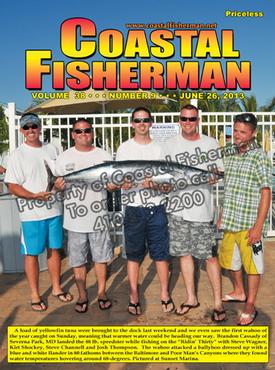


Article by Capt. Mark Sampson
 After guiding anglers for many years and watching thousands at all skill levels trying to put “bait-to-fish,” I've come to the conclusion that, given optimal conditions, most fishermen are pretty fair casters and can usually drop a bait at least “close enough” to have a shot at hooking whatever it is they’re trying to catch. The problem is, out on the water it’s common for fishermen to have “anything but” the type of conditions that allow for simple casts. Wind, currents, other boats, piers, bridges and long distances often make getting a hook to a fish very challenging if not close to impossible. But where there’s a will there’s a way, and eventually many fishermen either learn or invent techniques that will overcome whatever it is that’s keeping them from depositing their baits or lures to their quarry.
After guiding anglers for many years and watching thousands at all skill levels trying to put “bait-to-fish,” I've come to the conclusion that, given optimal conditions, most fishermen are pretty fair casters and can usually drop a bait at least “close enough” to have a shot at hooking whatever it is they’re trying to catch. The problem is, out on the water it’s common for fishermen to have “anything but” the type of conditions that allow for simple casts. Wind, currents, other boats, piers, bridges and long distances often make getting a hook to a fish very challenging if not close to impossible. But where there’s a will there’s a way, and eventually many fishermen either learn or invent techniques that will overcome whatever it is that’s keeping them from depositing their baits or lures to their quarry.
Take distance for instance. Of all the things that keep casters from reaching the strike-zone, too great a gap between fish and fisherman is the number one dilemma. If the fish are 100-yards away but you can only cast 75-yards you’ve got a problem. Sometimes anglers can get a bit more distance just by adding a little more weight to their line or switching to a lure that’s heavier and has less aerodynamic drag. But more often than not those options will not be available and anglers will have to find other, more creative ways to reach out to their fish.
One way to get the hooks where they need to be is to forget casting altogether and let the current do the work. By positioning the boat directly up current of where the fish are holding, anglers can sometimes drift floating lures or baits suspended under floats back to the fish. Once they get where they need to be, lures can be worked back into the current or baits left to hang in the strike zone. This same technique can be used to fish under or around objects that would hinder a normal cast such as low bridges or docks, or to get line way back behind the boat or out from a shoreline. By attaching a large float a few feet above their baits, Rt. 50 Bridge fishermen are able to use the current to carry their flounder rigs way out from the bridge and hook fish that would otherwise be unreachable by casting.
A different casting dilemma occurs when anglers must get baits or lures out to fish that are likely to spook if the offering plops down close by. Food raining from the sky is not a normal occurrence for most fish, so a sudden and noisy appearance of something, even though it looks like food, can send an entire school fleeing. A solution is to cast well beyond the quarry and then crank in the bait or lure so that it passes in front of the fish. Care must be taken not to cast directly over the fish; otherwise the line itself will likely spook them during the retrieve or the fish will see the bait coming and move off. Predators aren't accustomed to being attacked by their own prey.
Another way to get a bait or lure in front of spooky fish is to drop the line in the water and then make a wide circle around the fish with the boat while letting line out. Once on the other side, the line can be cranked back in, thus drawing the terminal end to the fish you’re trying to catch. A downside to this tactic is that you often have a lot of line off your reel before you even get a bite and if the fish are big and the tackle is light you could get “spooled.” The good thing is that if it is done properly, the bait or lure will follow a bit of an arch during the retrieval, giving a very lifelike appearance of a baitfish skirting around a school of predators.
The design and engineering of modern rods and reels has made it easier than ever for anglers of all skill levels to deliver accurate casts to the fish they’re trying to catch. But no engineering can account for all the unique challenges anglers will encounter. For that fishermen will always have to rely on their own experience and resourcefulness.
Captain Mark Sampson is an outdoor writer and captain of the charter boat “Fish Finder”, docked at the Ocean City Fishing Center.